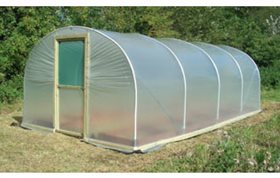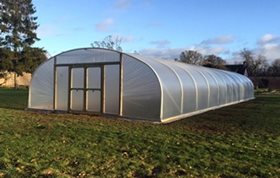If you’ve been growing your own fruits and vegetables and are looking for ways to boost your harvest, you may be considering investing in a polytunnel or greenhouse. Providing cover from harsh weather conditions and reducing pests, these can be ideal for extending the growing season, but which option should you choose?
In this guide, we have outlined the differences between polytunnels and greenhouses, as well as a variety of factors to think about when making your choice. Want to know which one is best for both your growing needs and your garden? Read on to find out!
Polytunnel or Plastic Greenhouse: What’s the Difference?
Essentially, both structures work in a similar way, providing a warmer environment to enhance growth during the summer and allow lower temperature plants to thrive in winter. This can help you grow a larger variety of produce (including more Mediterranean crops), in greater numbers and for a longer period. But what are the key differences?
 Polytunnels are constructed from galvanised steel hoops and tightly covered with clear or diffused plastic. Cheaper to buy, polytunnels require a smaller investment; at only the third of the cost of a greenhouse, polytunnels are excellent value for money. Polytunnels are usually built straight onto a soil base, with the only site preparation required being a simple site clearance. They’re also easier to dismantle, move and reassemble. The galvanised steel frame will last for 20 years and more, with the polythene generally needing to be replaced every 7 to 10 years. Polytunnels are available with a full range of additions and accessories to allow you to customise your polytunnel to suit the particular needs of you and your plants.
Polytunnels are constructed from galvanised steel hoops and tightly covered with clear or diffused plastic. Cheaper to buy, polytunnels require a smaller investment; at only the third of the cost of a greenhouse, polytunnels are excellent value for money. Polytunnels are usually built straight onto a soil base, with the only site preparation required being a simple site clearance. They’re also easier to dismantle, move and reassemble. The galvanised steel frame will last for 20 years and more, with the polythene generally needing to be replaced every 7 to 10 years. Polytunnels are available with a full range of additions and accessories to allow you to customise your polytunnel to suit the particular needs of you and your plants.
Greenhouses utilise an aluminium or metal frame glazed with glass or polycarbonate plastic. These can be expensive, especially if you choose toughened safety glass (recommended for family gardens or homes with young children). Greenhouses are also time consuming to construct, usually needing a solid base to stand on, and once erected they are difficult to dismantle. On the other hand, they’re hard wearing and durable.
Polytunnels and Plastic Greenhouses
No matter which you choose, options can be ideal, particularly if you’re new to growing your own fruit and vegetables and are interested in becoming more self-sufficient.
A small polytunnel or greenhouse can be assembled relatively quickly, is perfect for growing popular plants like tomatoes, and can be a great way to get kids into gardening. Additionally, they’re a great option for smaller outdoor spaces, from yards to cramped city gardens.
Big Polytunnel or Large Plastic Greenhouse
 A big polytunnel or large plastic greenhouse is an excellent choice for those who need more growing space. Whether this is because you’re a more experienced gardener and want to increase your variety of crops or require extra room for a commercial venture.
A big polytunnel or large plastic greenhouse is an excellent choice for those who need more growing space. Whether this is because you’re a more experienced gardener and want to increase your variety of crops or require extra room for a commercial venture.
Whatever the reason, a larger size will allow you to take your growing to the next level, both for personal and professional needs.
Factors to Consider
When deciding between these two structures and selecting the size, consider these factors:
Purchase price: Polytunnels are generally cheaper and require a smaller investment than greenhouses.
Construction time: Depending on the size, greenhouses can take longer to construct.
Site preparation: Ground must be level for a greenhouse while rougher ground can be more easily accommodated for a polytunnel.
Lifespan: Greenhouses can potentially last a lifetime, providing the glass doesn’t break or get blown out of the frame, whereas the covers on polytunnels will need replacing periodically, at a low cost, to maintain their efficiency.
Heat retention: Greenhouses often require more heat during the winter months, whereas a polytunnel covered with a Thermal polythene and without the drafts of a greenhouse, can help if you’re considering over-wintering crops.
Sun and shade: A diffused polythene sheeting on a polytunnel helps to prevent heat spots, but you may have to paint greenhouse panels to avoid sun damage, such as leaf scorch, to your produce.
Transportability: While both can be moved, greenhouses require more time and glass panels may present a higher risk of damage and injury.
Essentially, your choice will come down to your budget and requirements. However, we hope these tips will help you select the right growing option for your needs.